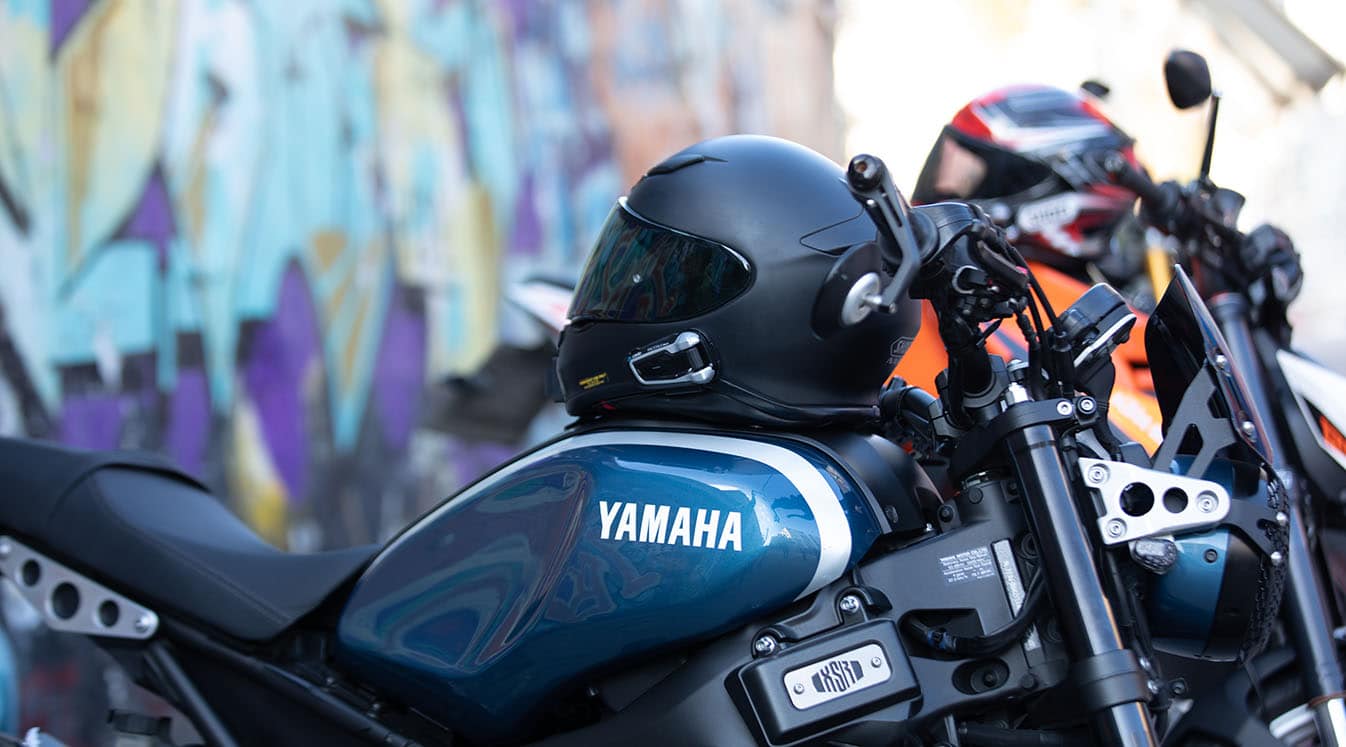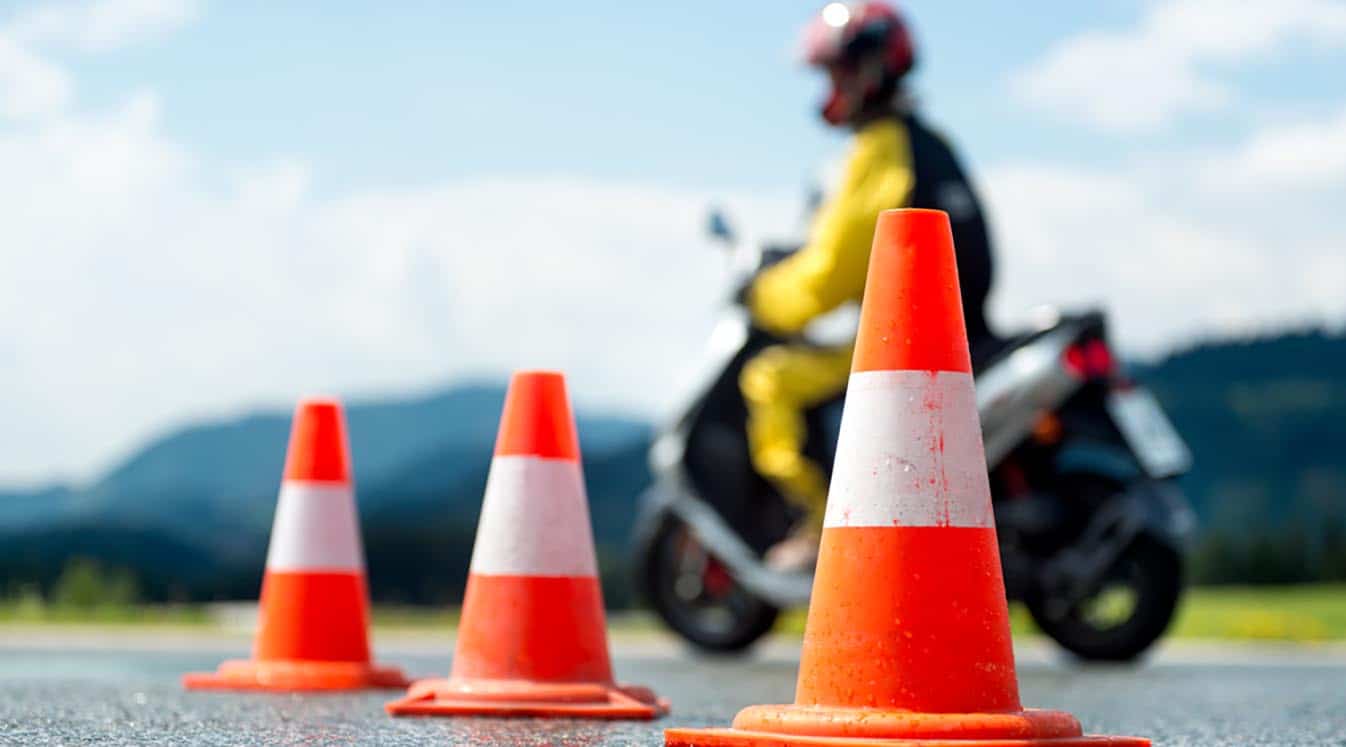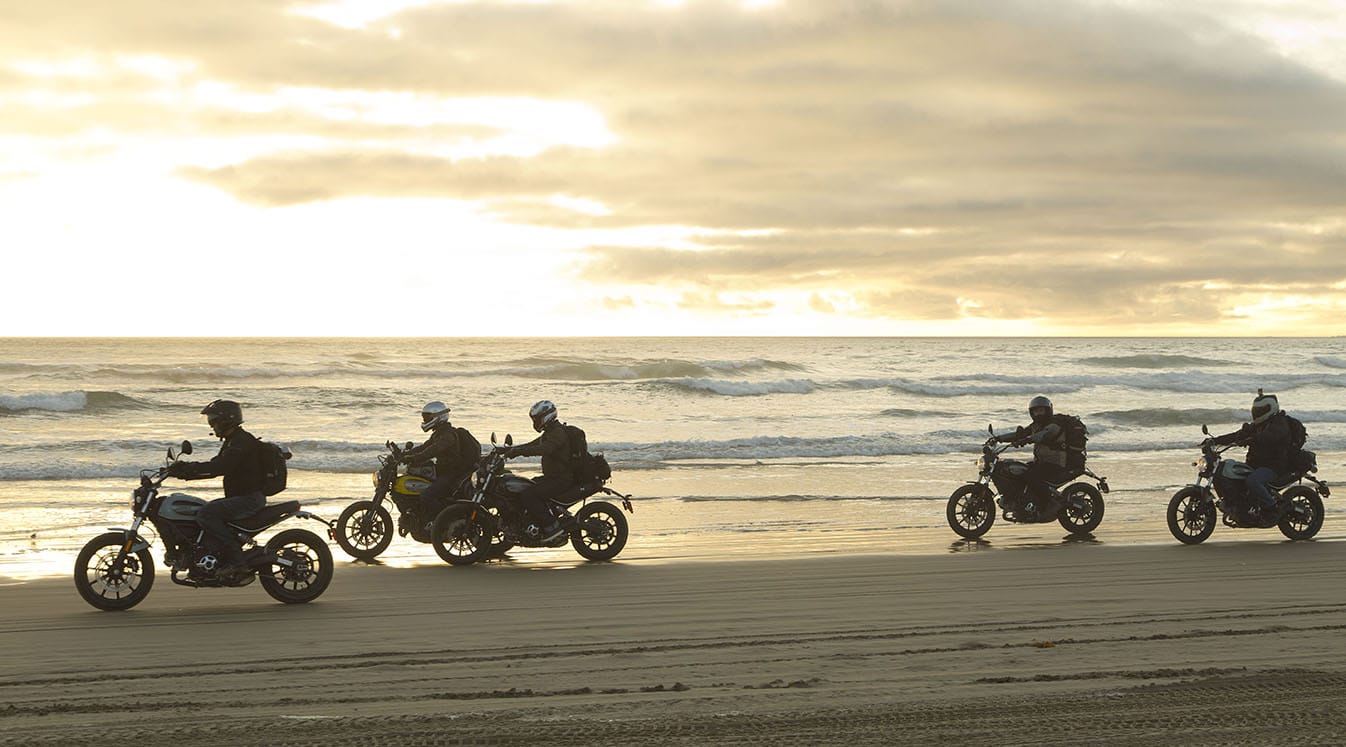But choosing a helmet can be easier said than done. There are lots of different motorcycle helmet styles to choose from. Use this guide to find the right safety gear and accessories for your new ride.
Understanding the Different Motorcycle Helmet Styles
If you’ve perused the helmet section at your local motorcycle shop, you probably realized that helmets come in all shapes and sizes. Most helmets cost between $150 and $500, but you can easily find a cheaper helmet for just $50, while the most expensive models can go for as much as $4,000 or more.
So, how do you choose so you’re not putting your life on the line?
Let’s start by going through all the different types of motorcycle helmets and how they’re used. Helmets usually fall into one of the following categories: full-face, modular, open face, half, off-road and dual sport.
Learn More about Modular and Full Face Helmets Here
Full-Face
Nothing beats a full-face helmet when it comes to safety and protection. The helmet wraps around your entire head and face with the most coverage around the neck. This is the preferred choice if you are trying to get from point A to point B unscathed. Full-face designs come with a chin bar for added protection. The chin tends to absorb a lot of pressure during impact, so be sure to protect it.
Choose a full-face helmet based on how you like to ride. If you prefer racing at high speeds, you’ll probably be sitting forward on the bike, so you may want a higher chin bar with a tilted visor. Go with a lower chin strap and a more direct-facing visor if you like to sit upright on the bike when cruising or exploring. Try sitting in various positions with the helmet attached to make sure it’s the right fit.

With maximum protection, a full-face helmet comes with everything you need to stay comfortable behind the wheel. They usually have vents on the sides to keep the air flowing on hot days, which helps reduce fog and perspiration. You probably won’t want to ride if it means sticking your head in an oven. You can also close the vents on the sides during the winter to stay warm. We lose most of our body heat through our heads, after all. Look for a helmet with different visor tints to increase visibility on sunny days.
If you’re looking for a tech-savvy helmet, full-face is probably the way to go. Most models come with advanced features, such as Bluetooth speakers, wireless communication and other sweet perks for a superior ride.
Open Face (3/4)
As the name implies, the open face helmet offers little in the way of face protection. The helmet covers the top and sides of the head, while leaving the face exposed. It covers around ¾ of your face, which explains the nickname. Open face helmets don’t come with a chin bar, which puts the lower half of your face at risk. It comes with a flip-up visor, which offers some protection from the sun and wind, but it won’t do much good if you get into a wreck. The helmet also doesn’t wrap around the bottom of your face, which can leave you vulnerable to flying bugs, gravel and other debris.
This style is popular among casual riders, tourists and parade types. You don’t want to go much faster than 30 MPH when you’re wearing an open face helmet. Some riders prefer this style because it lets them feel the wind on their face, but be careful when reaching peak speeds.
Others prefer the ¾ style because it weighs less than the full-face variety. Without the chin bar, the helmet should lose a few ounces, if not a full pound, but the drop in weight isn’t usually worth the risk of injury.

Modular (Flip-Up)
The modular, or flip-up, style combines aspects of both full-face and ¾ helmets. Like the full-face helmet, it wraps all the way around your head and face. But the included hinge allows you to flip up the visor and chin bar, which turns it into an open face helmet. It’s designed to give you the best of both worlds. Lots of riders like having the added coverage as well as the freedom to quickly flip up the chin bar if they need to take a drink or chat with their companion.
However, it’s important to note that modular helmets aren’t as safe as their full-face counterparts. The hinge adds extra weight, which puts additional pressure on your neck. Separating the visor and chin bar makes the helmet less secure than it would be if everything were connected. The visor could accidentally flip up during an accident, which would put your face at risk.
Half (1/2)
A notch below the ¾ style would be half – or ½ – helmets. They don’t offer as much protection, considering they leave most of your face and neck exposed. The helmet covers the top and sides of your head, usually extending down to the eyebrows and just below the ears. This is considered the minimal level of protection, so proceed at your own risk.
Some half helmets are simply a piece of metal or plastic and that’s about it. You can always bring your own goggles and eye protection, but it’s not quite the same as riding with a full-face. Most designs don’t come with advanced technological features, such as Bluetooth communication or speakers.
As you might expect, half helmets are much lighter than ¾ and full-face helmets. They also tend to be much cheaper, but you won’t feel as safe behind the wheel.
Off-Road
The off-road community always likes to do things differently, and the helmet is no exception. Whether you like to ride a dirt bike or race Motocross, you might need a different style of helmet.

These helmets are designed to take a beating, so you won’t find many technological features here. They are built for maximum protection from the outdoors. Off-road helmets come with a more accented chin bar for increased airflow on hotter days. Most are made out of fiberglass, Kevlar or carbon fiber to reduce the weight so your neck doesn’t get sore during a long ride.
You will recognize off-road helmets by the peak running across the top. This is designed to block the sun as well as trees and branches from hitting your face. The peak isn’t aerodynamic, so it will slow you down on the road. Most off-road helmets also don’t come with eye protection, so it’s best to wear goggles as well. Your eyewear should be flush with the helmet so nothing can slip through the cracks. You might want to buy goggles and a helmet from the same manufacturer to make sure they fit together.
Off-road helmets aren’t the best when riding on the highway, considering they’re made of lighter materials. If you’re going over 60 MPH, you’re better off with a heavier model.
Dual Sport (Crossover, Hybrid, ADV)
If you like to drive your bike to work and go exploring on the weekends, you’re not alone. That’s why the dual sport design exists. It combines elements of the full-face and off-road designs for versatile drivers who like to go where they please.
Dual sport helmets come with larger eye protection than full-face helmets, considering all the debris flying through the air. The visor also flips up, so you can easily attach goggles. However, hybrid helmets aren’t as off-road friendly as their outdoorsy counterparts.
Most dual sport helmets don’t come with a peak, which makes them more aerodynamic, but it also means less protection from the sun and falling debris. They also come with a less accented chin bar for less airflow, so you might get hot when cruising through the outdoors.
Let’s be honest – most of us like driving our motorcycles in more than one terrain. That’s why the dual sport model tends to be so popular. They also come with many of the same technological features that you’d expect from a full-face helmet, including Bluetooth capabilities and wireless communication.

Choosing a Helmet
Now that you know a thing or two about the different motorcycle helmet styles, you should have a better idea of what you’re looking for. There’s a lot to consider before making your final decision.
Safety Standards
You may not have a lot of say over your helmet style. Lots of states have strict laws regarding motorcycle helmet safety. They usually mandate that you wear a helmet that’s been approved by the U.S. Department of Transportation (DOT). The agency inspects helmets to make sure they will keep riders safe in the event of an accident. They check for various features, including impact force, energy distribution and the chances of the helmet staying on the person’s head.
Check your state’s motorcycle safety laws to see what’s required. You may have to wear a full-face helmet in certain situations. Look for the DOT stamp of approval before purchasing a helmet to make sure you comply with the law.
Essential Features
If your state doesn’t have any laws on the books, you might have to be your own helmet tester. Look for the following structural features to make sure the helmet will hold up in a pinch:

Outer Protection: The helmet should come with an outer shell, which is usually made of Kevlar, polycarbonate or molded plastic. This is your first line of defense during an impact. The outer shell should wrap all the way around your head.
Shock Absorption: There should also be an inner layer for absorbing the impact. It’s usually made of expanded polystyrene foam.
Rider Comfort: Look for a padded layer on the inside of the helmet. This is usually made of open cell foam for absorbing sweat and wicking away moisture.
Chin Strap: Make sure the helmet comes with a chin strap, which will keep the helmet attached to your head during a collision. The strap should be adjustable without being too tight or loose.
Face Shield or Visor: The helmet should also have a visor or face shield for keeping the wind, rocks and dead bugs out of your face.
Cheek Pads: These additional pads are designed to lock the helmet into place around your chin for a secure fit every time.
Vents: Air should be able to flow through the helmet so you can breathe behind the wheel. Make sure you can close them when the weather gets cold.
Additional Considerations
Motorcycle helmets have come a long way since the 1970s and ’80s. Today’s riders want all the luxury of riding in an automobile. If you like to stay in touch on the road, look for helmets that come with or support motorcycle communication systems. Lots of riders like to keep tabs on each other when riding or exploring in groups. You can always buy a separate communication system and install it yourself if the helmet doesn’t come with this technology.
Shop Motorcycle Communication Systems
Use Bluetooth motorcycle speakers to listen to crystal-clear audio on the road. You never know when you might have to make a call or look up directions. The speakers should tune out the noise of your bike for a better listening experience.

It’s also good to find a quality headset so you can speak clearly during your ride. Look for motorcycle headsets that support hands-free calling on and off the road.
Choosing a motorcycle helmet is easy when you know what you’re looking for. Keep this information in mind as you continue your search for the perfect helmet.





